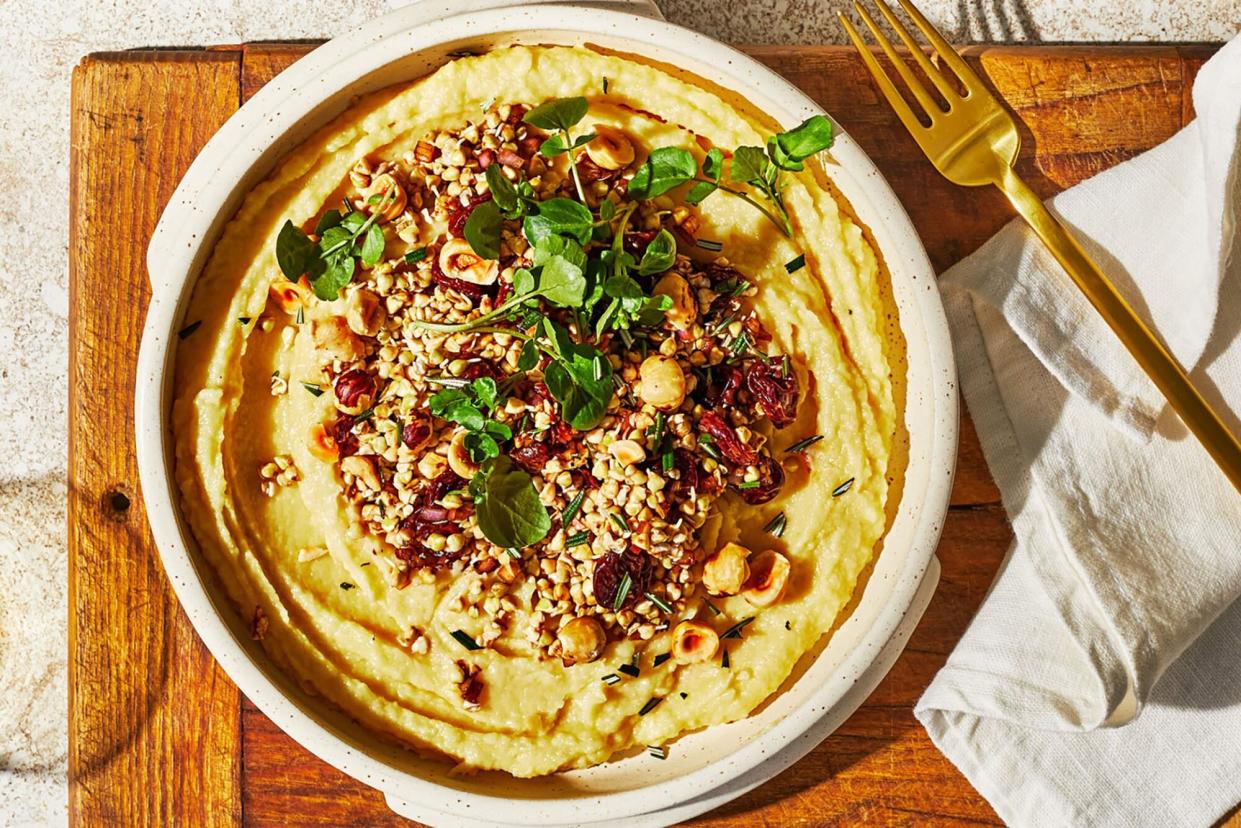This Parsnip Purée Is the Ultimate Healthy Mashed Potato Dupe

Caitlin Bensel
Unpopular opinion: Mashed potatoes are overhyped. Oftentimes, the tubers aren't given the TLC they need to shine (think: a thorough whipping, a few generous pinches of salt, and lots of butter), leaving dinner guests disappointed with the bland side dish and the hosts with leftovers.
To ensure your company retires with full stomachs and happy hearts, take a break from your taters and instead try this parsnip purée recipe created by Abra Berens, the executive chef at Granor Farm in Michigan and the author of Grist: A Practical Guide to Cooking Grains, Beans, Seeds, and Legumes (Buy It, $30, amazon.com). Ultra creamy and mildly sweet, this parsnip purée takes just 30 minutes to go from pot to plate — no longer than standard mashed potatoes — and the addition of toasted hazelnuts and cooked buckwheat gives the side dish some crunch. (Related: 12 Ancient Grains to Switch Up Your Healthy Carbs)
Flavor aside, you'll also score some key nutrients from the parsnip purée. While potatoes pack a bit more protein than parsnips, the root veggie has a leg up on the tuber when it comes to fiber, offering more than twice the amount per serving, according to the United States Department of Agriculture. Reminder: Fiber is a component of plant foods that your body can't digest, and it helps to regulate your number twos and keep you feeling full, according to the Mayo Clinic. But that's not the only nutrient boost you'll get from this silky parsnip purée; a 100-gram serving of the veggie also provides nearly 17 percent of the recommended dietary allowance for folate, a B vitamin that is crucial for women of childbearing age, as a deficiency increases the risk of having a baby with neural tube defects, per the National Institutes of Health. In comparison, an equal serving of potatoes offers just under 4 percent of the RDA.
Convinced to break up with mashed potatoes — or at least put a temporary pause on your relationship? Add this parsnip purée to this week's dinner menu. (Then use up the rest of the taters to make these incredible fries.)
Parsnip Purée with Buckwheat, Dried Cherries, and Hazelnuts
Start to finish: 30 minutes
Serves: 4
Ingredients:
3/4 cup extra-virgin olive oil
1 yellow onion, thinly sliced
Kosher salt and freshly ground black pepper
1/2 cup white wine or hard cider
3 lb. parsnips, peeled and cut into chunks
1/2 cup dried cherries
1 shallot, minced
1/4 cup balsamic vinegar
1/2 cup hazelnuts, toasted and smashed
1 sprig rosemary, needles removed and finely chopped
Fresh greens, optional
1 cup cooked and chilled buckwheat or 1 cup untoasted buckwheat grouts*
Directions:
In a medium saucepan, heat 1/4 cup oil over medium-low heat. Add onion and 1/2 teaspoon salt, and sweat until soft, about 10 min.
Add wine and reduce until almost dry, about 5 min. Add parsnips and 3/4 cup water, and bring to a simmer. Cover the pot halfway with a lid, and let simmer until parsnips are tender, about 15 min.
Using a food processor or an immersion blender, purée the mixture until very smooth. Season with salt and pepper.
Meanwhile, soak dried cherries and shallot in balsamic vinegar and a pinch of salt for 10 min. Combine the cherry mixture with hazelnuts, rosemary, and remaining 1/2 cup oil. Season with salt and pepper.
Just before serving, combine buckwheat with the cherry-hazelnut mixture. Dish the purée into serving bowls, and top with the buckwheat-cherry mixture. Finish with a handful of greens if desired.
*You can sprout the buckwheat for this recipe, which makes it edible without cooking. To do: Soak the groats in warm water for 15 min. Drain, rinse, and transfer to a bowl, cover with a tea towel, and let sit until you see "tails" start to form (rinsing the groats a couple of times a day to remoisten) in 2 to 3 days.
Recipe adapted from Grist: A Practical Guide to Cooking Grains, Beans, Seeds, and Legumes by Abra Berens with permission by Chronicle Books, 2021.

